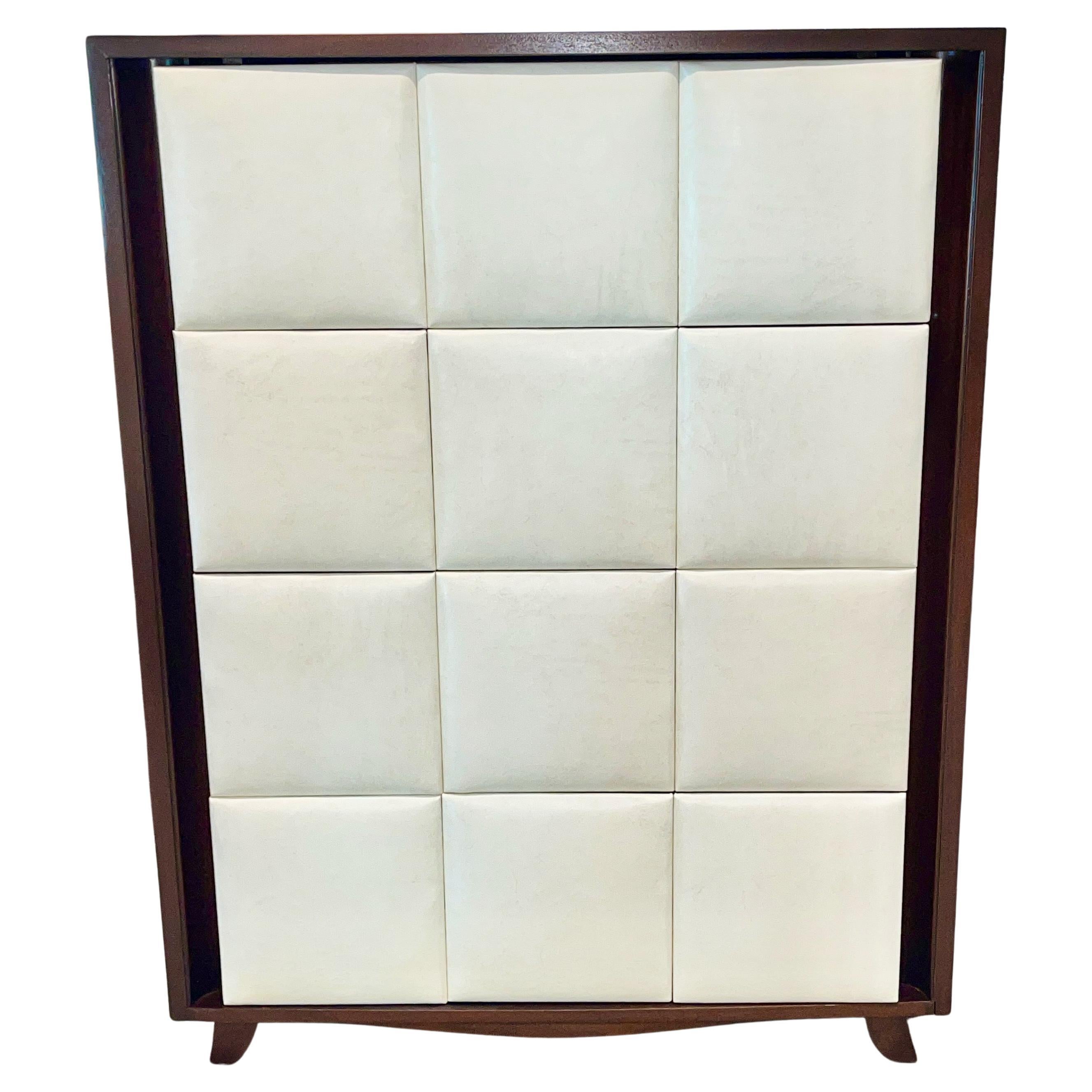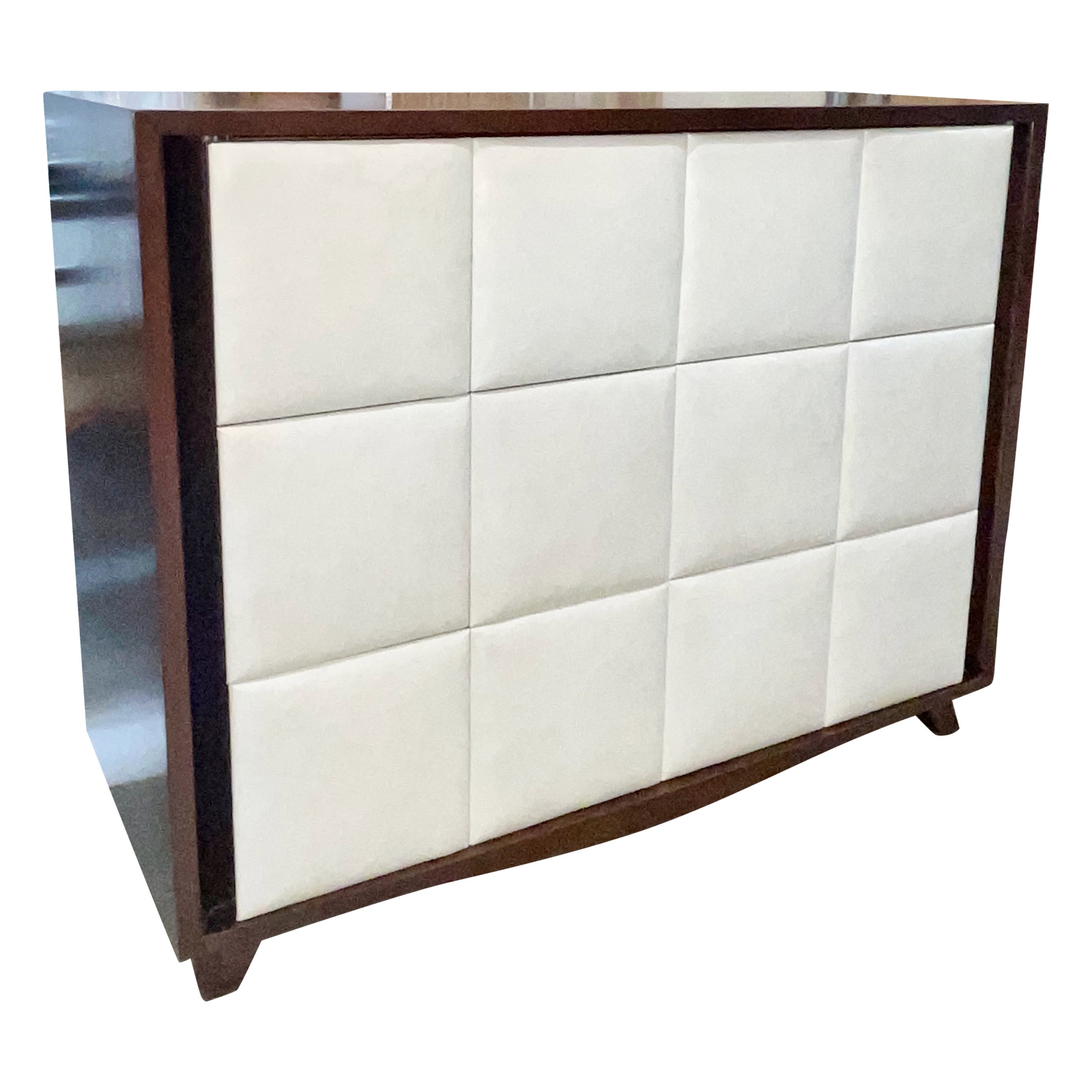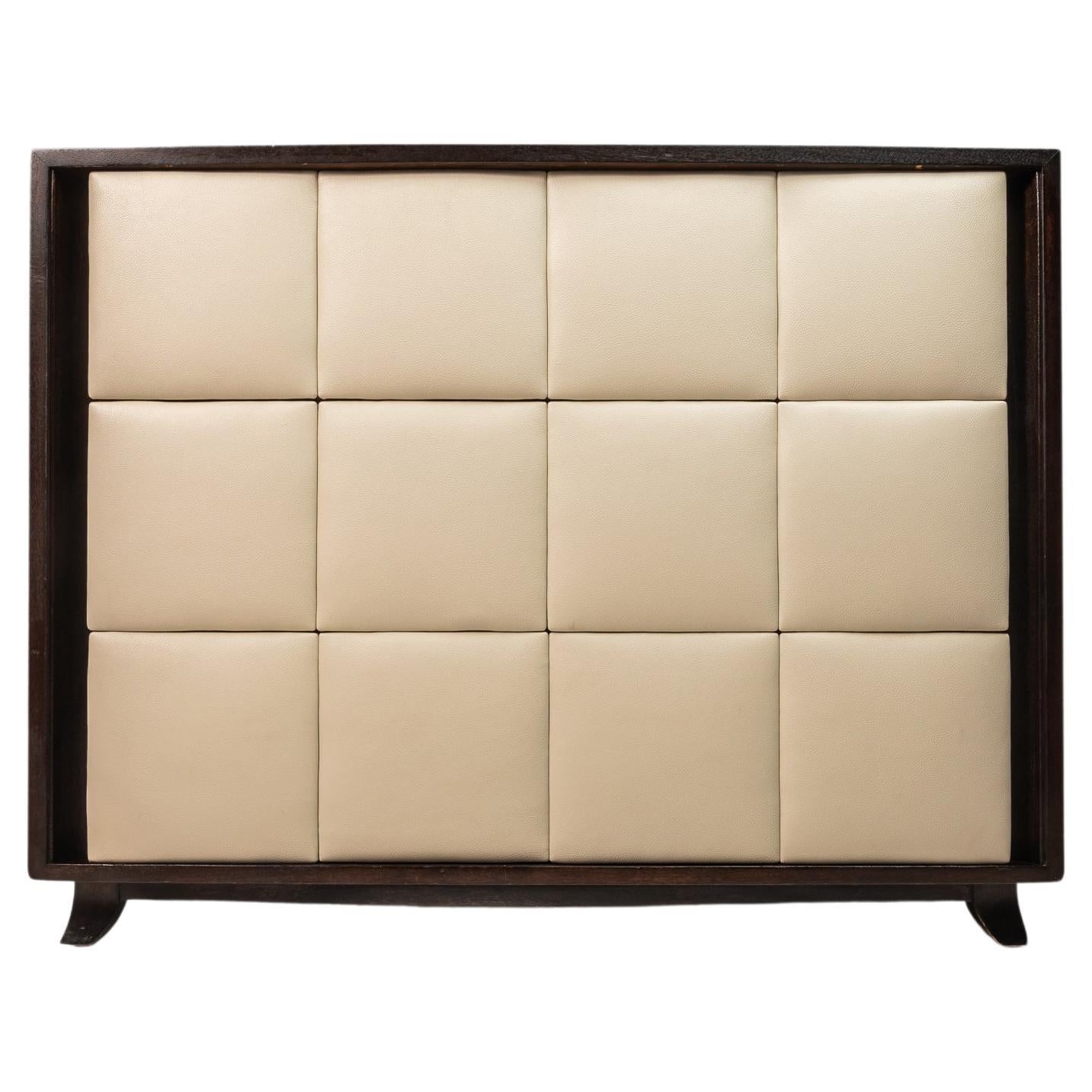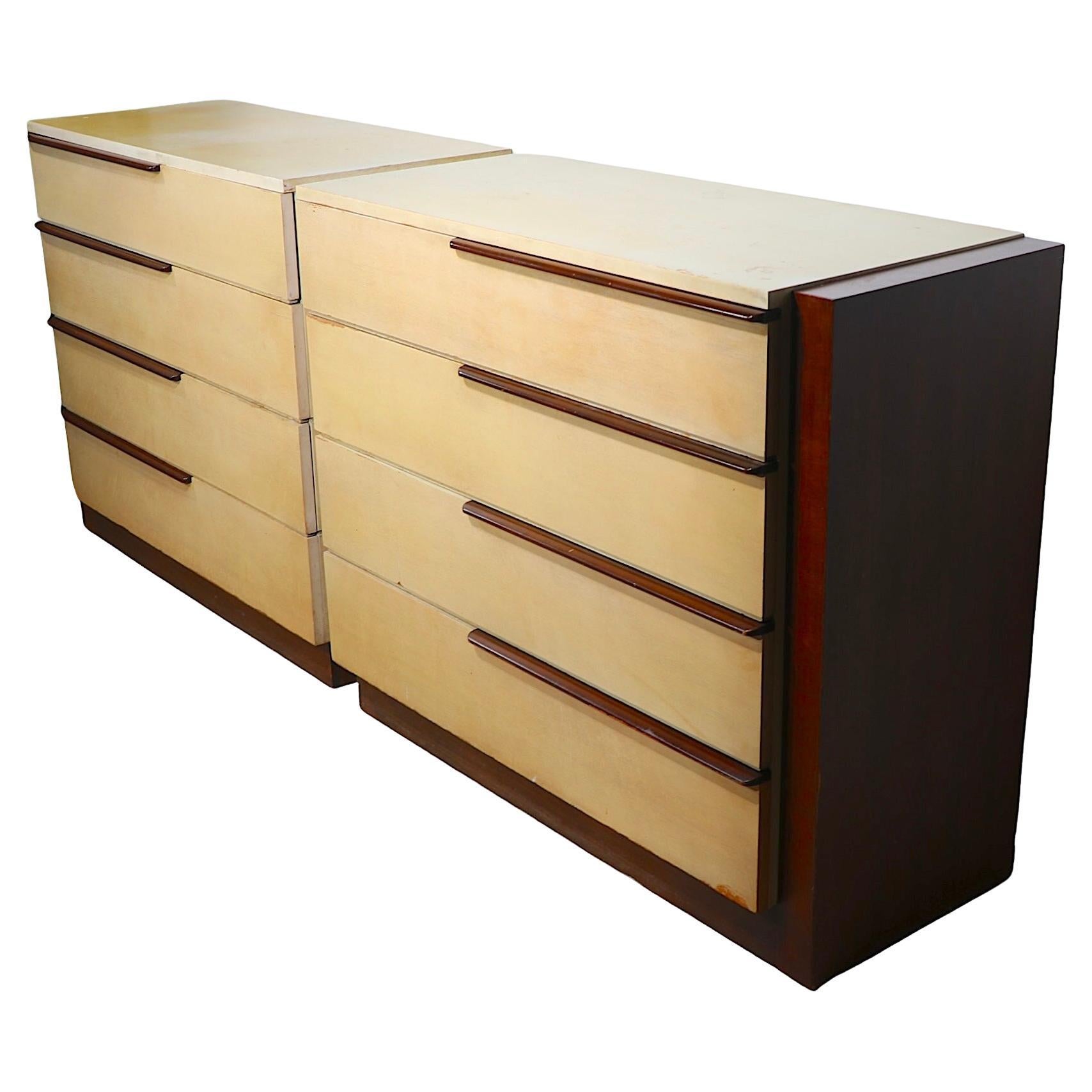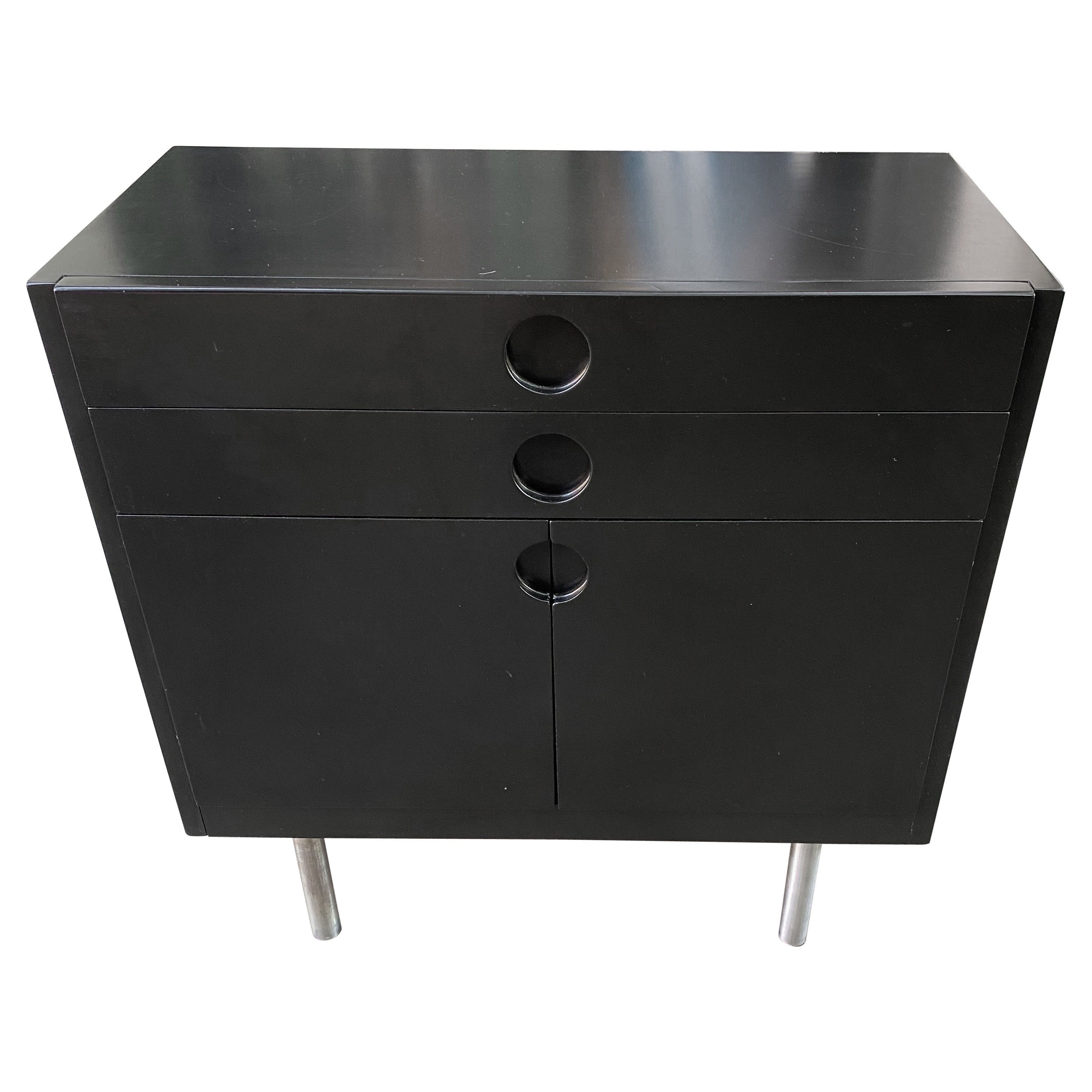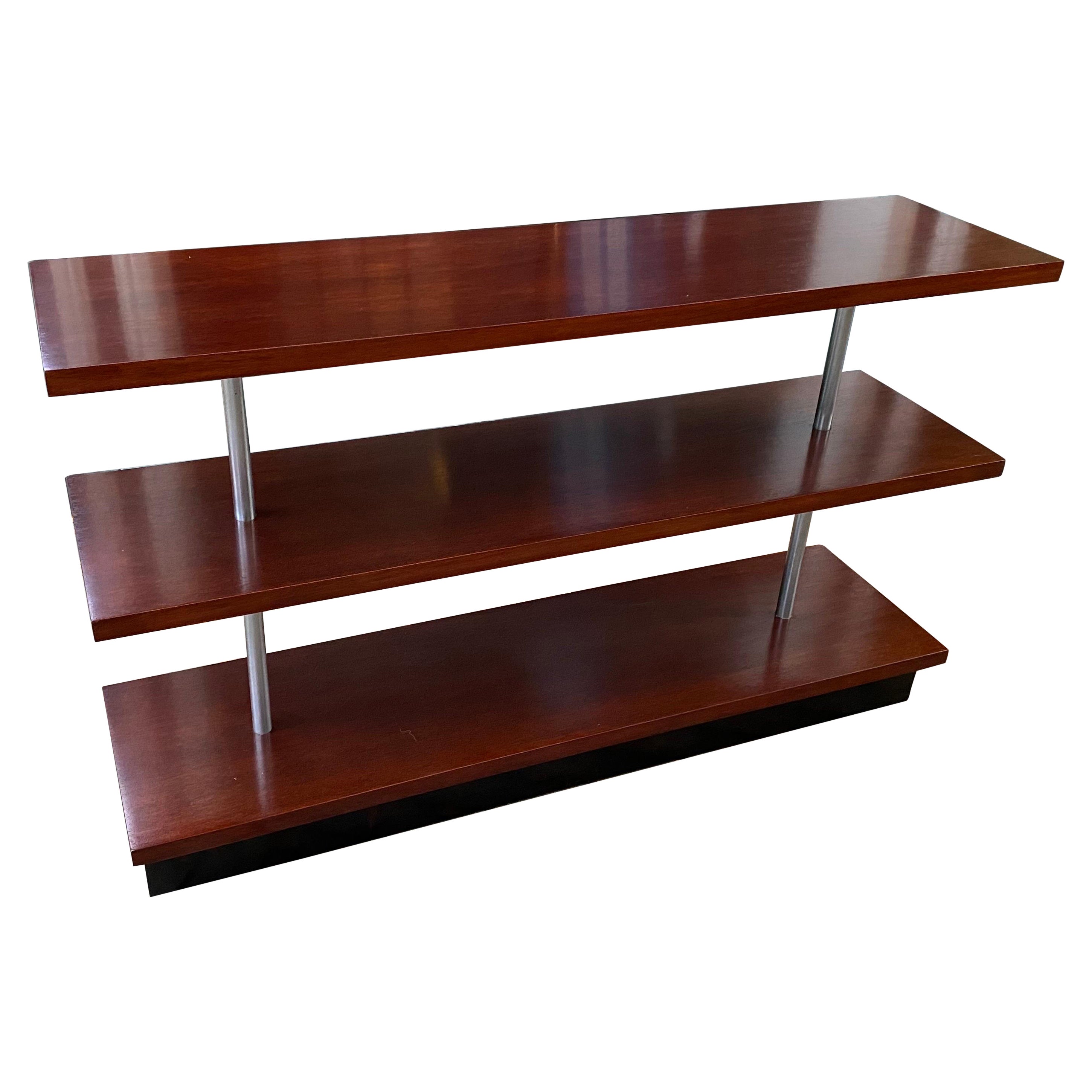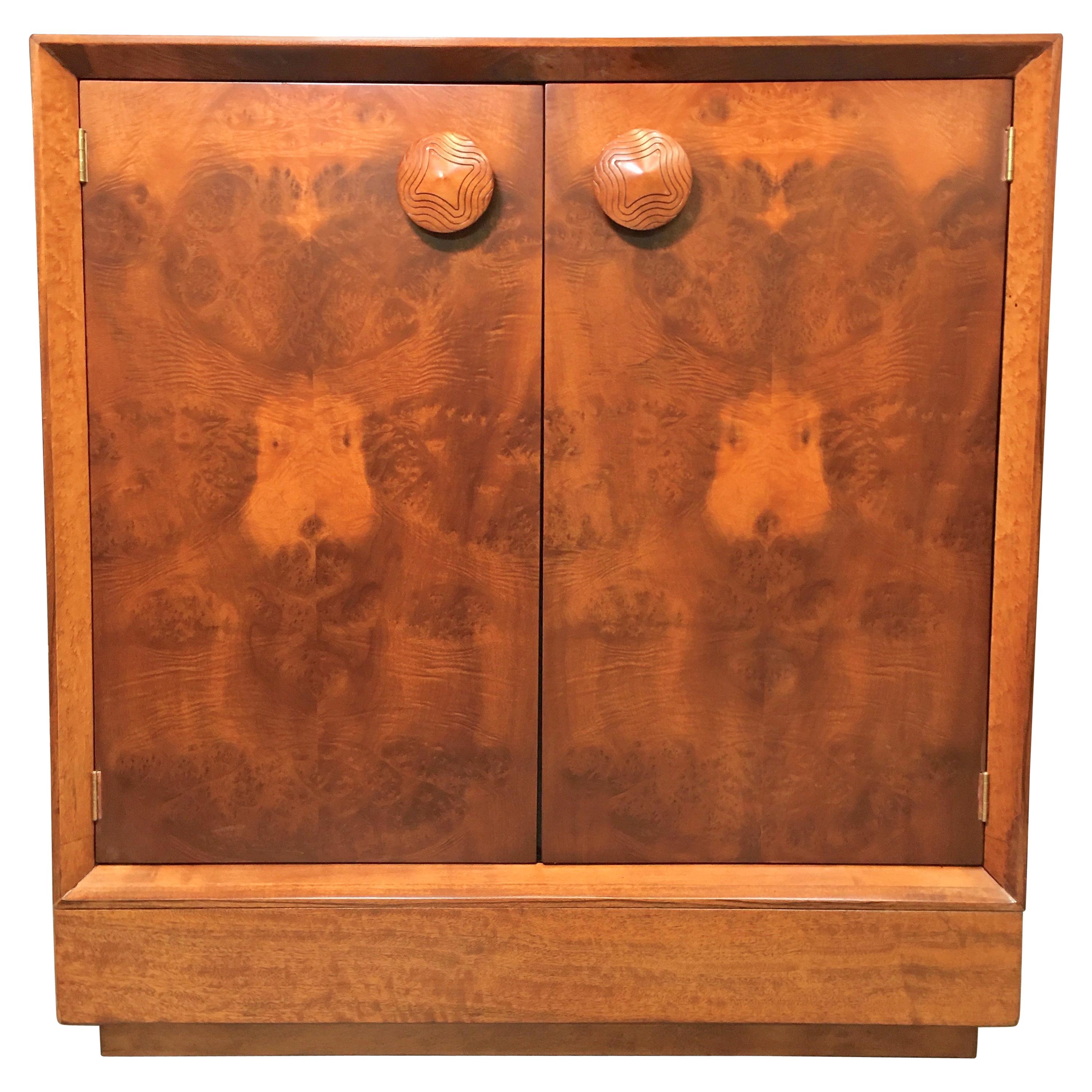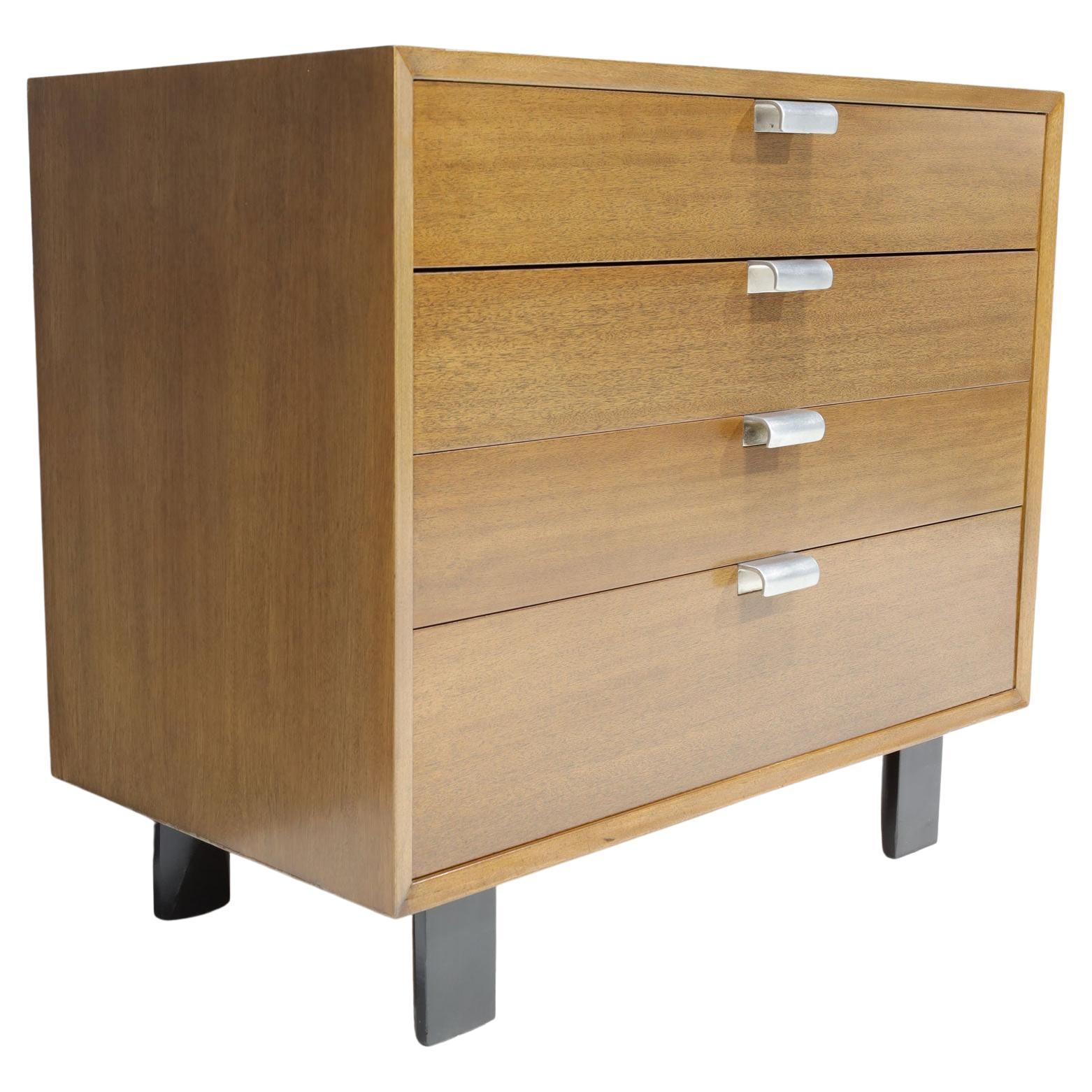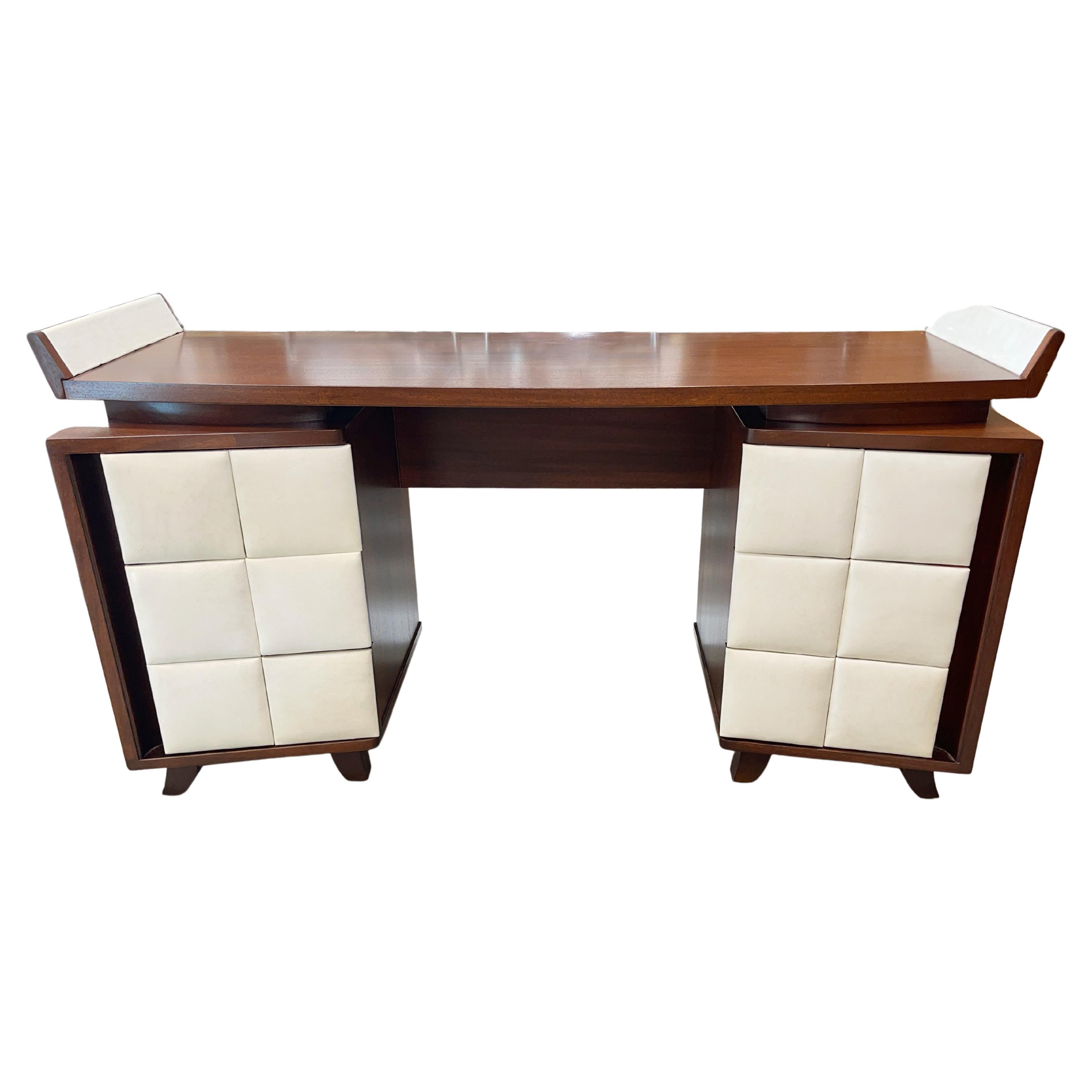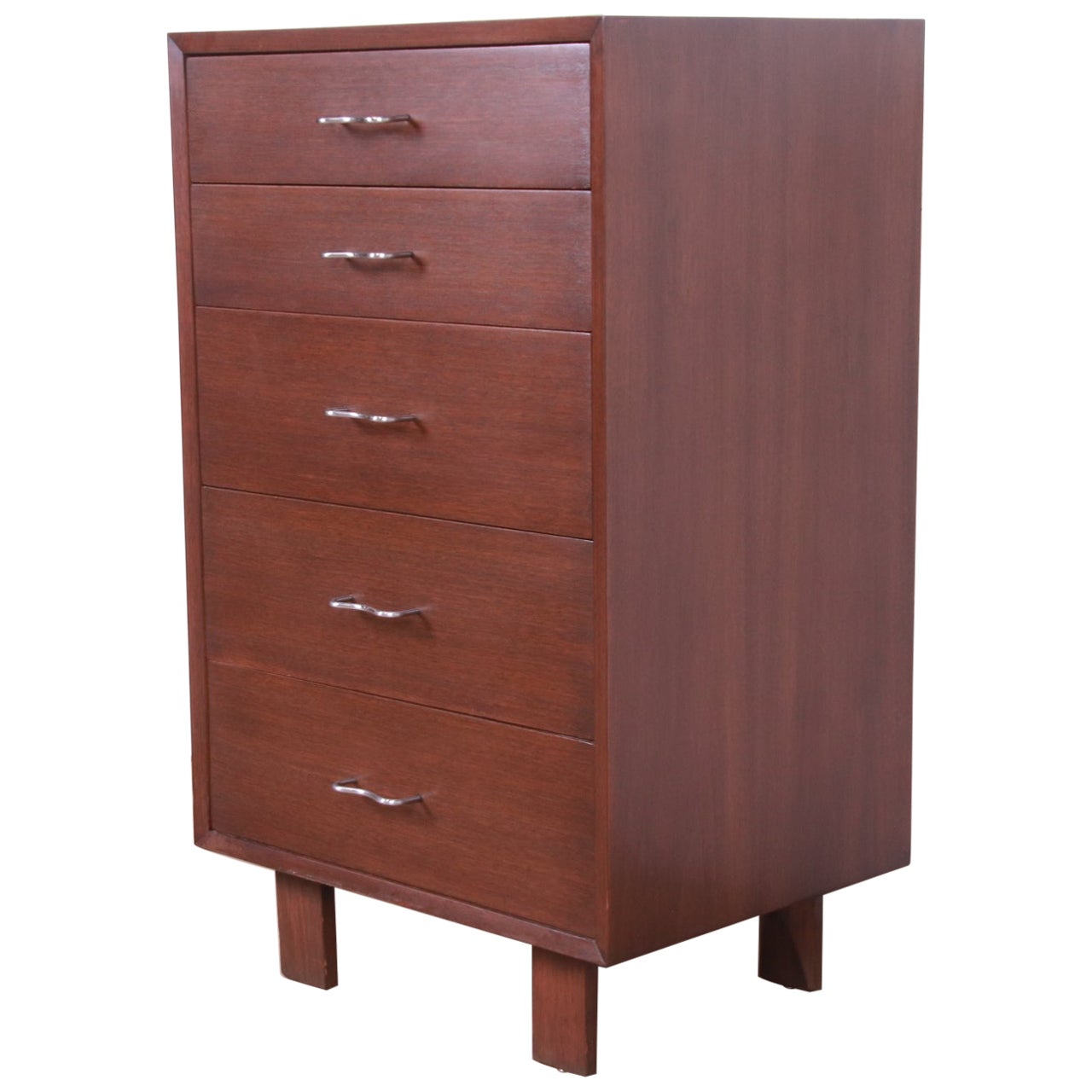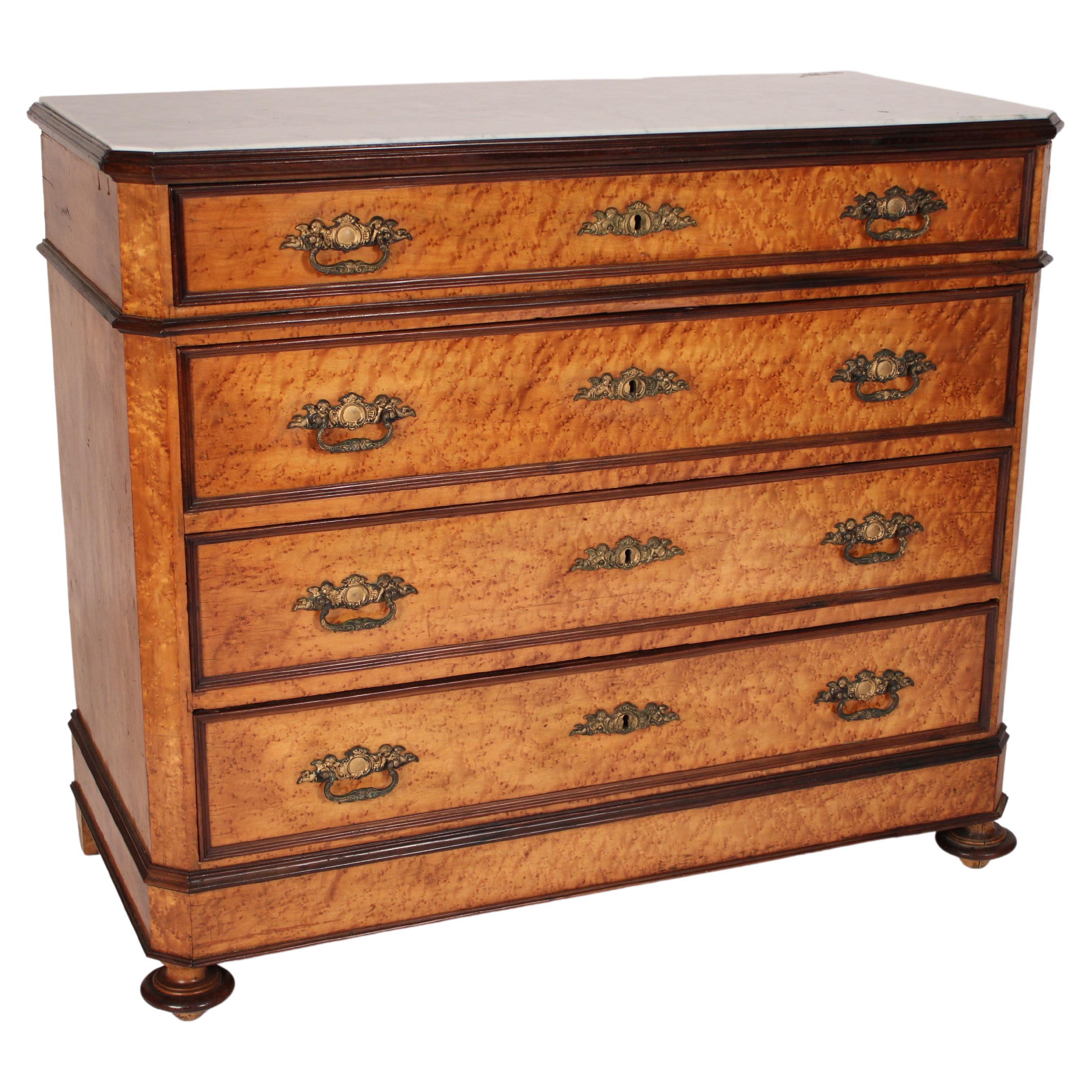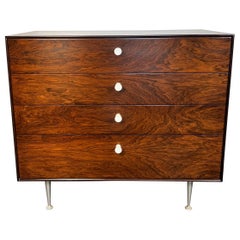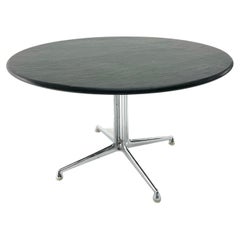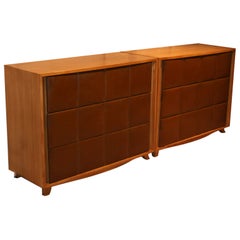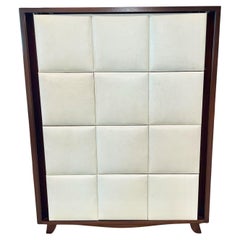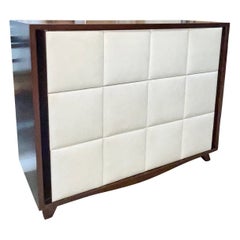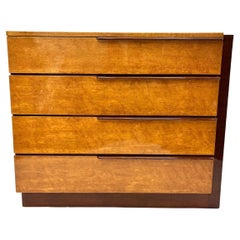
Gilbert Rohde Chest of Drawers for Herman Miller in Birdseye Maple and Mahogany
View Similar Items
Gilbert Rohde Chest of Drawers for Herman Miller in Birdseye Maple and Mahogany
About the Item
- Creator:Herman Miller (Manufacturer),Gilbert Rohde (Designer)
- Dimensions:Height: 36 in (91.44 cm)Width: 43 in (109.22 cm)Depth: 19 in (48.26 cm)
- Style:Mid-Century Modern (Of the Period)
- Materials and Techniques:
- Place of Origin:
- Period:
- Date of Manufacture:circa 1940s
- Condition:Refinished.
- Seller Location:San Diego, CA
- Reference Number:1stDibs: LU6417238025462
Gilbert Rohde
Pioneering self-taught industrial designer, writer and teacher Gilbert Rohde helped define the earliest phase of modernism in the United States. He is one of the most influential figures of 20th-century design and is credited with helping legendary mid-century modern furniture manufacturer Herman Miller avert financial disaster during the Great Depression.
Born in New York City, Rohde studied painting at the Art Students League after high school. He found lucrative employment, first as a political cartoonist and then as a catalog illustrator for American department stores. He was particularly enthralled with drawing furnished interiors.
Rohde began to design furniture in his spare time. He traveled to the Bauhaus school in Germany and the International Exhibition of Modern Decorative and Industrial Arts in Paris, and drew on the Art Deco movement and the work of designers such as Émile-Jacques Ruhlmann in his early pieces. Rohde opened his own studio in 1929 and secured private and commercial commissions. His clients would come to include formidable furniture makers Heywood-Wakefield and Troy Sunshade, and his innovative bentwood furnishings for them were practical and intended for the modern consumer.
In 1930, Rohde met Herman Miller founder D.J. De Pree in the company’s Michigan showroom during a business trip. By then, Rohde had a long list of prominent clients and his furniture had been exhibited in museums and galleries. Herman Miller was weathering a devastating slowdown in business, and the American furniture industry had generally been hit hard by the Great Depression.
Rohde boldly informed De Pree that the brand’s furniture had become outdated, which was part of the reason the company was in financial jeopardy. Homes had become smaller and could no longer accommodate the large Gothic– and Victorian–style furnishings and traditional reproductions of period bedroom suites that Herman Miller was offering at the time, Rohde explained.
Rohde secured a contract to design for the Michigan manufacturer. He championed the use of exotic woods and tubular steel, and created streamlined, unadorned bedroom furniture for Herman Miller — collections that included convenient vanities, which were unconventional pieces for De Pree’s company back then.
In 1933, Rohde oversaw the design of two bedrooms featuring sleek Herman Miller furniture — including innovative storage pieces he designed — as part of an International–style exhibit at the 1933 Chicago World’s Fair. The installation garnered acclaim for De Pree’s brand all over the world and afforded Rohde the opportunity to execute on his visionary ideas in front of a global audience. Rohde later designed lighting, seating and more for Herman Miller and was extensively involved in the company's marketing strategy and other areas of the business.
In 1942, Herman Miller, anticipating a postwar economic boom, began to produce office furniture for the first time, but its legacy is in the home. Working with legendary designers such as Ray and Charles Eames, Isamu Noguchi and Alexander Girard, the manufacturer fostered some of the boldest expressions of what we now call mid-century modern style.
Find vintage Gilbert Rohde coffee tables, lounge chairs, table lamps and other items on 1stDibs.
Herman Miller
No other business of its kind did more than the Herman Miller Furniture Company to introduce modern design into American homes. Working with legendary designers such as Charles and Ray Eames, George Nelson and Alexander Girard, the Zeeland, Michigan-based firm fostered some of the boldest expressions of what we now call mid-century modern style. In doing so, Herman Miller produced some of the most beautiful, iconic and, one can even say, noblest chairs, sofas, tables and other furniture ever.
Founded in 1923, Herman Miller was originally known for grand historicist bedroom suites: heavily ornamented wood furniture that appealed to a high-minded, wealthier clientele. The company — named for its chief financial backer — began to suffer in the early 1930s as the Great Depression hit, and D.J. De Pree, the company’s CEO, feared bankruptcy. In 1932, aid came in the form of Gilbert Rohde, a self-taught furniture designer who had traveled widely in Europe, absorbing details of the Art Deco movement and other modernist influences. After persuading De Pree that the growing middle class required smaller, lighter household furnishings, Rohde set a new course for Herman Miller, creating sleek chairs, tables and cabinetry that were the essence of the Streamline Moderne style.
Rohde died suddenly in 1944. The following year, De Pree turned to George Nelson, an architect who had written widely about modern furniture design. Under Nelson’s leadership, Herman Miller would embrace new technologies and materials and audacious biomorphic forms.
Some of the pieces the company produced are now emblems of 20th century American design, including the Eames lounge chair and ottoman and Nelson’s Marshmallow sofa and Coconut chair. Such instantly recognizable furnishings have become timeless — staples of a modernist décor; striking, offbeat notes in traditional environments.
Find a range of vintage Herman Miller office chairs, desks, coffee tables and other furniture on 1stDibs.
- George Nelson Rosewood Thin Edge 4 drawer Dresser by Herman Miller #2By George NelsonLocated in San Diego, CAA rosewood thin edge chest designed by George Nelson for Herman Miller with exquisite rosewood grain and early original white porcelain handles. The George Nelson Rosewood Thin Edge 4-drawer Dresser, crafted by Herman Miller, epitomizes the timeless elegance and functional sophistication synonymous with mid-century modern design. This dresser stands as an iconic piece within the George Nelson collection, renowned for its clean lines, minimalist aesthetic, and impeccable craftsmanship. This particular example boasts exquisite rosewood grain and early original white porcelain handles. Constructed from rich rosewood veneer, the dresser boasts a warm, organic hue that exudes luxury and refinement. Its slender profile and thin edges create an illusion of lightness, enhancing the overall sense of modernity and grace. The 4 spacious drawers feature seamless integration of hardware, maintaining the dresser's sleek appearance while providing ample storage space for clothing, linens, or personal belongings. Each detail of the George Nelson Rosewood Thin Edge series reflects an unwavering commitment to both form and function. Its timeless design transcends trends, making it a versatile addition to any interior decor scheme, from minamalist to post-modern. Whether used in a bedroom, living area, or office space, this dresser elevates the ambiance with its understated elegance and unparalleled craftsmanship, showcasing the enduring legacy of George Nelson's visionary design ethos. About the Designer: Not everyone thinks of George Nelson when they think “Modernism”—but they should. Here’s why: Looking at the outset of George Nelson’s career, few would have guessed that his legacy would crown him as one of the most influential individuals in Modernism—story has it that the young Ivy Leaguer stumbled into the Yale School of Architecture seeking shelter from the rain, and only then did he consider studying design. His legacy, though, would be one that touched nearly every corner of American Modernism as we think of it today. As an architect, author, furniture designer, graphic designer, exhibition designer, teacher, amateur photographer, and general provocateur, George Nelson shaped the course of design in America for over four decades. After completing his two Bachelor’s degrees (one in architecture, the other in fine arts), Nelson went on to accept a traveling fellowship in Rome, which interfaced him with figures like Ludwig Mies Van Der Rohe, Walter Gropius, Le Corbusier, and Gio Ponti all of which he interviewed forPencil Point, bringing the European vanguard to the attention of the magazine’s American readership. At this point in his career, Nelson had devoted himself to writing, joining Architectural Forum as its first associate editor in 1935. For nearly a decade, Nelson’s post as an editor brought him face-to-face with many of the leaders of the Modernism movement in the U.S., and through these exchanges, his own stance in the design world began to solidify. For Nelson, the purpose of design was to improve the world in accordance with the laws of nature—and while he hadn’t yet done much designing himself, he was busy teasing out the theoretical details of architecture. In 1940, Nelson co-authored Tomorrow’s House with Henry Wright, and the book went on to be a great commercial success, introducing concepts like the “family room,” and more broadly assuming a solutions-based perspective for architectural design. It wasn’t long before the book earned him the favorable attention of D.J. Depree, the chairman of Herman Miller the American furniture manufacture. Despite Nelson’s inexperience in furniture design, Depree saw potential in the writer’s approach to the industry: solutions-oriented design with a practical lean. Nelson became the company’s Director of Design in 1947, under the condition that he be allowed to continue his work outside of the company. From 1947 to 1972, Nelson oversaw the design department at Herman Miller, bringing in the icons that would shape some of the most memorable pieces of mid-century design, from such people as Ray and Charles Eames and Harry Bertoia to Richard Schultz, Donald Knorr, and Isamu Noguchi. Beginning in the mid-1950s, Nelson’s own design firm began its work in earnest, producing furniture and pioneering a ubiquitous incorporation of design, bringing that same consideration for pragmatism and aesthetics to advertising and marketing materials, image management, and graphic programs. His own firm incorporated in 1955, tapping many of the same designers from the Herman Miller roster for collaborations under George Nelson Associates, Inc. It was during this period of Nelson’s life and career that many of his most iconic designs came onto the scene—many will be instantly familiar furniture silhouettes that perhaps you didn’t know sprung from George Nelson himself. Designing his first collection in 1945 and appointed design director in 1947, Nelson quickly expanded his purview and transformed the company. Confirming De Pree’s early assessment of Nelson as someone “thinking well ahead of the parade,” he redesigned everything from Herman Miller’s product line to its graphics and marketing and advertising materials. Over the course of his long association with Herman Miller, Nelson designed hundreds of pieces of furniture and recruited other designers, including Charles and Ray Eames, Alexander Girard, and Isamu Noguchi, now all widely acknowledged as some of the brightest talents of the time. Nelson developed his own designs—from furniture to architecture, and exhibitions to graphics—in his New York City studio, known variously over the years as George Nelson, George Nelson & Associates, and George Nelson and Company. The staff included significant designers in their own right such as Irving Harper, George Mulhauser, Ernest Farmer, Gordon Chadwick, George Tscherny...Category
Vintage 1950s American Mid-Century Modern Dressers
MaterialsAluminum
$5,864 Sale Price20% Off - George Nelson Rosewood Thin Edge 4 drawer Dresser by Herman Miller #1By George NelsonLocated in San Diego, CAA rosewood thin edge chest designed by George Nelson for Herman Miller with exquisite rosewood grain and early original white porcelain handles. The George Nelson Rosewood Thin Edge 4-drawer Dresser, crafted by Herman Miller, epitomizes the timeless elegance and functional sophistication synonymous with mid-century modern design. This dresser stands as an iconic piece within the George Nelson collection, renowned for its clean lines, minimalist aesthetic, and impeccable craftsmanship. This particular example boasts exquisite rosewood grain and early original white porcelain handles. Constructed from rich rosewood veneer, the dresser boasts a warm, organic hue that exudes luxury and refinement. Its slender profile and thin edges create an illusion of lightness, enhancing the overall sense of modernity and grace. The 4 spacious drawers feature seamless integration of hardware, maintaining the dresser's sleek appearance while providing ample storage space for clothing, linens, or personal belongings. Each detail of the George Nelson Rosewood Thin Edge series reflects an unwavering commitment to both form and function. Its timeless design transcends trends, making it a versatile addition to any interior decor scheme, from minamalist to post-modern. Whether used in a bedroom, living area, or office space, this dresser elevates the ambiance with its understated elegance and unparalleled craftsmanship, showcasing the enduring legacy of George Nelson's visionary design ethos. About the Designer: Not everyone thinks of George Nelson when they think “Modernism”—but they should. Here’s why: Looking at the outset of George Nelson’s career, few would have guessed that his legacy would crown him as one of the most influential individuals in Modernism—story has it that the young Ivy Leaguer stumbled into the Yale School of Architecture seeking shelter from the rain, and only then did he consider studying design. His legacy, though, would be one that touched nearly every corner of American Modernism as we think of it today. As an architect, author, furniture designer, graphic designer, exhibition designer, teacher, amateur photographer, and general provocateur, George Nelson shaped the course of design in America for over four decades. After completing his two Bachelor’s degrees (one in architecture, the other in fine arts), Nelson went on to accept a traveling fellowship in Rome, which interfaced him with figures like Ludwig Mies Van Der Rohe, Walter Gropius, Le Corbusier, and Gio Ponti all of which he interviewed forPencil Point, bringing the European vanguard to the attention of the magazine’s American readership. At this point in his career, Nelson had devoted himself to writing, joining Architectural Forum as its first associate editor in 1935. For nearly a decade, Nelson’s post as an editor brought him face-to-face with many of the leaders of the Modernism movement in the U.S., and through these exchanges, his own stance in the design world began to solidify. For Nelson, the purpose of design was to improve the world in accordance with the laws of nature—and while he hadn’t yet done much designing himself, he was busy teasing out the theoretical details of architecture. In 1940, Nelson co-authored Tomorrow’s House with Henry Wright, and the book went on to be a great commercial success, introducing concepts like the “family room,” and more broadly assuming a solutions-based perspective for architectural design. It wasn’t long before the book earned him the favorable attention of D.J. Depree, the chairman of Herman Miller the American furniture manufacture. Despite Nelson’s inexperience in furniture design, Depree saw potential in the writer’s approach to the industry: solutions-oriented design with a practical lean. Nelson became the company’s Director of Design in 1947, under the condition that he be allowed to continue his work outside of the company. From 1947 to 1972, Nelson oversaw the design department at Herman Miller, bringing in the icons that would shape some of the most memorable pieces of mid-century design, from such people as Ray and Charles Eames and Harry Bertoia to Richard Schultz, Donald Knorr, and Isamu Noguchi. Beginning in the mid-1950s, Nelson’s own design firm began its work in earnest, producing furniture and pioneering a ubiquitous incorporation of design, bringing that same consideration for pragmatism and aesthetics to advertising and marketing materials, image management, and graphic programs. His own firm incorporated in 1955, tapping many of the same designers from the Herman Miller roster for collaborations under George Nelson Associates, Inc. It was during this period of Nelson’s life and career that many of his most iconic designs came onto the scene—many will be instantly familiar furniture silhouettes that perhaps you didn’t know sprung from George Nelson himself. Designing his first collection in 1945 and appointed design director in 1947, Nelson quickly expanded his purview and transformed the company. Confirming De Pree’s early assessment of Nelson as someone “thinking well ahead of the parade,” he redesigned everything from Herman Miller’s product line to its graphics and marketing and advertising materials. Over the course of his long association with Herman Miller, Nelson designed hundreds of pieces of furniture and recruited other designers, including Charles and Ray Eames, Alexander Girard, and Isamu Noguchi, now all widely acknowledged as some of the brightest talents of the time. Nelson developed his own designs—from furniture to architecture, and exhibitions to graphics—in his New York City studio, known variously over the years as George Nelson, George Nelson & Associates, and George Nelson and Company. The staff included significant designers in their own right such as Irving Harper, George Mulhauser, Ernest Farmer, Gordon Chadwick, George Tscherny...Category
Vintage 1950s American Mid-Century Modern Dressers
MaterialsAluminum
- La Fonda coffee table by Alexander Girard for Herman MillerBy Charles Eames, Herman MillerLocated in San Diego, CALa Fonda coffee or large end table designed by Charles and Ray Eames and manufactured by Herman Miller. This series was designed for the La Fonda restaurant, designed by Alexander Gi...Category
Vintage 1960s American Mid-Century Modern Coffee and Cocktail Tables
MaterialsSlate, Chrome
$2,205 Sale Price25% Off - Arne Vodder "Triennale" Teak Dresser with Blue Bowtie Drawers for Sibast MøblerBy Arne VodderLocated in San Diego, CAAn iconic design by Arne Vodder 'Triennale' dresser was produced by Sibast Mobler, circa 1950. Constructed in teak, the long eight drawer dresser is a classic piece of danish modern ...Category
Mid-20th Century Swedish Scandinavian Modern Dressers
MaterialsTeak
- Milo Baughman Cabinet in Walnut and Black Lacquer for DirectionalBy Milo BaughmanLocated in San Diego, CADesigned by Milo Baughman for the Directional Furniture Company, this handsome mid-century modern walnut cabinet would work well as a wardrobe in bedroom or in an office. The tall u...Category
Vintage 1960s American Dressers
MaterialsWalnut, Lacquer
- George Nakashima "Origins' Walnut Dresser for WiddicombBy George Nakashima, Widdicomb Furniture Co.Located in San Diego, CAA very rare and exceptional mid-century Organic Modern monumental triple dresser. The Origins Group was created by George Nakashima, widely considered one of the world's greatest ...Category
Mid-20th Century American Mid-Century Modern Dressers
MaterialsBrass
$24,476 Sale Price20% Off
- Pair of Chest of Drawers by Gilbert Rohde for Herman MillerBy Herman Miller, Gilbert RohdeLocated in Palm Springs, CAA pair of three drawer chests, designed by Gilbert Rohde for Herman Miller in the the 1930's. Bleached mahogany cabinets with original padded naugahyde drawer fronts. Great detailing...Category
20th Century American Commodes and Chests of Drawers
MaterialsMahogany, Naugahyde
- Gilbert Rohde 4140 Tall Chest for Herman MillerBy Gilbert Rohde, Herman MillerLocated in Hanover, MABeautifully refinished mahogany tall boy chest of four drawers by Gilbert Rohde for Herman Miller's 4140 collection with original off-white "leather cloth" (Fabrikoid) padded drawers. Top drawer is fitted with vide poche sliding and removable tray. See pages from original 1941 Herman Miller catalog...Category
Vintage 1940s American Art Deco Commodes and Chests of Drawers
MaterialsFaux Leather, Mahogany
- Gilbert Rohde 4140 Dresser for Herman Miller 3 AvailableBy Gilbert Rohde, Herman MillerLocated in Hanover, MAWe have a total of three available of these beautifully refinished mahogany chests of three drawers by Gilbert Rohde for Herman Miller's 4140 collection with original off-white "leather cloth" (Fabrikoid) padded drawers. Top drawer is fitted with vide poche sliding and removable tray and has original label. See pages from original 1941 Herman Miller catalog...Category
Vintage 1940s American Art Deco Commodes and Chests of Drawers
MaterialsFaux Leather, Mahogany
- Gilbert Rohde for Herman Miller Three Drawer Chest Dresser Leather Drawer FacesBy Herman Miller, Gilbert RohdeLocated in Deland, FLIntroducing a rare Model 4140 three drawer dresser designed by Gilbert Rohde for Herman Miller. Produced in the 1940's this prime example of Art Deco Design is constructed from a wal...Category
Vintage 1940s American Modern Dressers
MaterialsLeather, Mahogany
- Pr Art Deco Art Moderne Dressers by Gilbert Rohde for Herman Miller c 1930'sBy Herman Miller, Gilbert RohdeLocated in New York, NYChic pair of streamline Art Moderne dressers designed by Gilbert Rohde, for Herman Miller c 1936. The dressers feature opposing right and left c...Category
Vintage 1930s American Art Deco Dressers
MaterialsBirdseye Maple, Walnut
- Gilbert Rohde Cabinet for Herman MillerBy Gilbert Rohde, Herman MillerLocated in Philadelphia, PAGilbert Rohde Cabinet from the Mahogany Series dating to the late 1930's. Refinished about 10 years ago in a Satin Black Finish. Still presents pretty well but not perfect. Retains O...Category
Vintage 1930s American Art Deco Cabinets
MaterialsMetal
Recently Viewed
View AllRead More
The 21 Most Popular Mid-Century Modern Chairs
You know the designs, now get the stories about how they came to be.
A Guide to Herman Miller’s Most Iconic Furniture
The prolific manufacturer has partnered with many of the world’s top designers since opening its doors in 1923. Here are some of the company’s greatest hits, which helped transform the American home and office.

